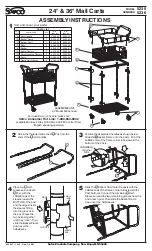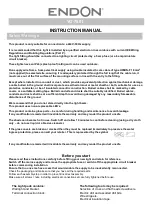
13
GB
Storage
WARNING!
Mould may form if the product is not stored
properly.
• Store the product in a clean, dry, well-ven-
tilated location away from direct sunlight,
where it is not exposed to major temperature
fluctuations.
• When not in use for an extended period, we
recommend completely disassembling the
product, and storing the individual parts of the
foil and the board in the corresponding carry
bags (16/17).
• Store the product in a secure place, out of
reach of children.
• Do not place heavy or sharp objects on the
product.
• After an extended storage period, check the
product for wear and tear, or signs of ageing.
Repairs
WARNING!
Before every use, check the board for pressure
loss, holes or tears.
If the board is leaking air, this could be due to a
leaking valve, a defective valve, or a leak in the
board itself.
Under no circumstances should you attempt to
repair larger damaged areas yourself.
You can repair minor damage with the repair kit
(19) provided.
Valve
To check whether the valve is leaking or defec-
tive, proceed as follows:
1. Turn the valve cap (1a) anticlockwise and
remove it from the valve (1b).
2. Ensure that there is no sand or other foreign
objects in the valve.
3. Fully inflate the board (1).
4. Close the valve.
5. Rinse the area of the board around the valve
with soapy water.
If bubbles form around the valve,
the valve must either be tightened or
replaced.
• Tightening the valve (Fig. E):
1. Turn the valve cap (1a) anticlockwise and
remove it from the valve (1b).
2. Place the valve key (18) on the valve until it
fully grips the valve.
3. Tighten the valve by turning the valve key
clockwise.
4. Close the valve with the valve cap and rinse
the area of the board (1) around the valve
with soapy water.
When there are no more bubbles, the valve
is tight.
• Replacing the valve (Fig. E):
If bubbles are still forming around the valve,
even after you have tightened it, it will need to
be replaced.
1. Allow the board (1) to deflate completely.
2. Turn the valve cap (1a) anticlockwise and
remove it from the valve (1b).
3. Place the valve key (18) on the valve until it
fully grips the valve.
4. Turn the valve key anticlockwise until the valve
can be removed from the board.
5. Remove the defective valve from the board.
6. Insert a new valve into the board.
Note:
you may order a replacement valve from
the customer service address below. For optimal
sealing, we recommend that you smear a little
silicone grease or petroleum jelly around the
valve.
7. Place the valve key onto the valve and tighten
the valve by turning it clockwise.
8. Place the valve cover on the valve and tighten
it by turning it clockwise.
Leaks
Only repair leaks on the board (1) with a suita-
ble adhesive. Repairs with unsuitable adhesive
can lead to further damage!
You can find suitable adhesives in spe-
cialist stores.
Note:
small leaks (smaller than 2mm) can also
be repaired with just the adhesive, by applying
it directly to the leaky area. Larger leaks (larger
than 2mm) can be repaired as follows:
1. Allow the board (1) to deflate completely.
2. Thoroughly clean the area to be repaired.
3. Dry the cleaned area.
4. Cut a patch that is large enough to cover the
damaged area and extend 1.5cm around it
on all sides.
5. Apply the adhesive to the leak and to the
patch itself. Let the adhesive dry for approx.
2–4 minutes.
6. Firmly press the patch onto the leak with a soft
object. Be sure to work on an even surface
without any creases or folds. Using a rounded
object, gently remove any bubbles, moving
outwards from the centre.
7. Let the adhesive dry for at least 12 hours after
the repair.
8. After the drying process is complete, add
more adhesive to the edges of the patch.
9. Let the adhesive dry for approx. 4 hours.
Important: before taking the board
into the water after repairing it, test the
repaired area to check that it is sealed.
Under no circumstances should you
attempt to repair very large damaged
areas yourself. Take the board to a
specialist repair shop.
Maintenance
Check regularly that the air pump (14) is well
lubricated before and during operation.
To lubricate, open the top covers and apply a
thin layer of oil or grease to the seals and the
pipes.
Disposal
Dispose of the article and the packaging materi-
als in accordance with current local regulations.
Packaging materials such as foil bags are not
suitable to be given to children. Keep the pack-
aging materials out of the reach of children.
Dispose of the products and the
packaging in an environmentally
friendly manner.
The recycling code is used to identify
various materials for recycling. The code
consists of the recycling symbol – which
is meant to reflect the recycling cycle – and a
number which identifies the material.
Service handling
IAN: 363938_2007
Service Great Britain
Tel.:
00800-88080808
E-Mail: [email protected]
Summary of Contents for 363938 2007
Page 3: ...3 B 14 14a 15a 15 C 15b 1a 1b D 1c 1a E 1a 18 1b ...
Page 4: ...4 F 6 8 9 5 3 4 2 7 7 ...
Page 5: ...5 G 7 7 10 10 1 5 1a 7 7 ...
Page 6: ...6 I 13 H 13 1f 13a 13b 1 ...
Page 17: ...17 ...
Page 18: ...18 ...
Page 19: ...19 ...






































